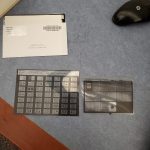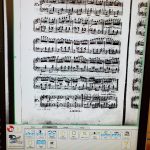
HPNL is home to a large number (> 26,000 separate bibliographic records) of the library’s microfiche. It should be noted that one microfiche bibliographic record may represent 1 microfiche, it may represent 10,000 (with the same call number but are differentiated by year, volume, etc.), so the number of microfiche titles is not the same as the number of actual sheets of microfiche. Microfiche comes in one of two sizes, 3.5”x 4.25” and 4” x 5.5”. Both are stored in 6” x 4” acid free envelopes and, if more than one sheet is stored in the same envelope, separated by an acid-free slip sheet matching the size of the microfiche. Microfiche vary in thickness. Their contents are accessed using a microform (microfilm/microfiche) reader.
Anything in print can be microphotographed to create microfiche; not only books, but also large collections of serials/journals/magazines (from philosophical societies to Ladies’ Home Journal), newspapers, government documents, musical scores… you get the idea.

Why still utilize microfiche? For some titles, we may hold the hard copy of the microfiche’s content, but they may be in such poor condition that handling it is problematic (brittle, large, degraded from past poor or absent preservation). Many items have not been digitized yet and won’t be for years, particularly older, non-English language pieces, so microfilm or microfiche are good way for old pieces to be accessed without damage to the original, although not as conveniently as a digital copy. Also, for example, a series of journals from the 19th century that take up a shelf and a half in the bowels of the Main Stacks can be held in one hand on microfiche. Microfiche are very compact. When space it at a premium, microforms allow for more room.
But, microfiche can degrade too. But, if kept within proper temperature and humidity guidelines, they may remain shelf stable far longer than their original medium. When microfiche degrades, it off-gasses a vinegary odor.

In HPNL, we have been and continue to rehouse poorly stored and cataloged microfiche. That includes using acid-free envelopes and slip sheets and boxes (they look like shoe boxes) designed specifically for the safe storage of multiple microfiche at once.
We are also in the process of making sure all microfiche (either individually or in logical ‘bundles,’ i.e., volumes, chapters, etc. according to the number of microfiche that can safely be bundled in the same envelope with slip sheets) are barcoded so that there is no delay at the circulation point during check out.

Also, during the physical processing of each microfiche sheet, the digital record of the item in hand is verified. Does the item match the bibliographic record? Some records are Marcettes, bare bones information on the title. OCLC is consulted for a more descriptive record and, if one is found, is used so that the record more accurately matches the piece(s). If no OCLC record can be located, the microfiche are sent to Cataloging for original cataloging work.

Many times the location or discoverability of the items in hand are incorrect. Many that have been physically located in HPNL are listed as Main Stacks or even Error Location (the system doesn’t know where the item is) in the record; this is corrected as the piece is processed. Also, many are hidden from patron view for one reason or another (considered long-term missing, for example). If the item is in hand, it is no longer missing, and the record will be updated with the current information and the suppression of the record will be lifted; patrons will know, and be able to locate, the items that have been languishing unnoticed in the collection all along.

Over the past few years, HPNL has positioned itself to become the storage location for microfiche collections from other units (HPNL has absorbed microfiche from Mathematics, International Areas Studies, and Art and Architecture collections), as HPNL has the storage capabilities (temperature- and humidity-controlled space) and staffing for the processing and care of microfiche. Microfiche from many other (now defunct) locations have been and continue to be found during processing in our collection as well as items that have no digital record (and therefore no connection to any location). There are still microfiche in the sub-basement of the Main Stacks that will, I assume, eventually be processed into HPNL, so the number of microfiche under HPNL administration will continue to grow in the future.